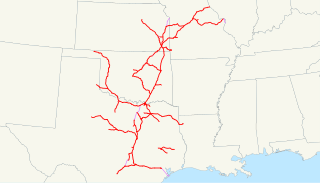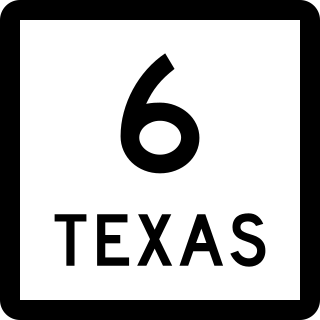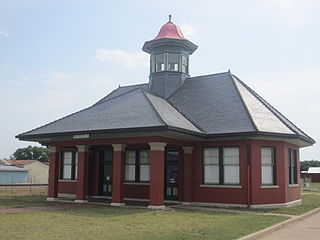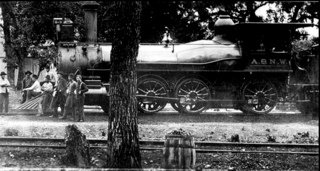
Ennis is a city in eastern Ellis County, Texas, United States. The population is 20,159 according to the 2020 census, with an estimated population of 21,210 in 2021. Ennis is home to the annual National Polka Festival.

The Missouri–Kansas–Texas Railroad was a Class I railroad company in the United States, with its last headquarters in Dallas, Texas. Established in 1865 under the name Union Pacific Railroad (UP), Southern Branch, it came to serve an extensive rail network in Texas, Oklahoma, Kansas, and Missouri. In 1988, it merged with the Missouri Pacific Railroad; today, it is part of UP.

State Highway 6 (SH 6) runs from the Red River, the Texas–Oklahoma state line, to northwest of Galveston, where it is known as the Old Galveston Highway. In Sugar Land and Missouri City, it is known as Alvin-Sugarland Road and runs perpendicular to Interstate 69/U.S. Highway 59 (I-69/US 59). In the Houston area, it runs north to Farm to Market Road 1960 (FM 1960), then northwest along US 290 to Hempstead, and south to Westheimer Road and Addicks, and is known as Addicks Satsuma Road. In the Bryan–College Station area, it is known as the Earl Rudder Freeway. In Hearne, it is known as Market Street. In Calvert, it is known as Main Street. For most of its length, SH 6 is not a limited-access road. In 1997, the Texas Legislature designated SH 6 as the Texas Korean War Veterans Memorial Highway.

The St. Louis Southwestern Railway Company, known by its nickname of "The Cotton Belt Route" or simply "Cotton Belt", is a former Class I railroad that operated between St. Louis, Missouri, and various points in the U.S. states of Arkansas, Tennessee, Louisiana, and Texas from 1891 to 1980, when the system added the Rock Island's Golden State Route and operations in Kansas, Oklahoma, and New Mexico. The Cotton Belt operated as a Southern Pacific subsidiary from 1932 until 1992, when its operation was assumed by Southern Pacific Transportation Company.

The International – Great Northern Railroad (I&GN) was a railroad that operated in the U.S. state of Texas. It was created on September 30, 1873, when the International Railroad and the Houston and Great Northern Railroad merged. The railroad was officially incorporated as the International & Great Northern Railroad Company.
The Buffalo Bayou, Brazos, and Colorado Railway, also called the Harrisburg Road or Harrisburg Railroad, was the first operating railroad in Texas. It completed its first segment of track between Harrisburg, Texas and Stafford's Point, Texas in 1853. The company established a western terminus at Alleyton, Texas prior to the Civil War. The railroad was sold after the war and reincorporated as the Galveston, Harrisburg, & San Antonio Railroad. This right of way was acquired by the Southern Pacific Railroad and is today a property of the Union Pacific Railroad.

The Texas and New Orleans Railroad was a railroad in Texas and Louisiana. It operated 3,713 miles (5,975 km) of railroad in 1934; by 1961, 3,385 miles (5,448 km) remained when it merged with parent company Southern Pacific.

The Gulf, Colorado and Santa Fe Railway was a subsidiary of the Atchison, Topeka & Santa Fe Railway. From its starting point in Galveston, Texas, the railroad eventually extended northwestwards across the state to Sweetwater and northwards via Fort Worth to Purcell, Oklahoma.

The Texas Electric Railway is a historic interurban railroad that operated from Dallas, Texas, to Denison, Corsicana, and Waco. It began operation in 1908 and through the merger of several companies became the largest interurban railway operator in the South before its demise in 1948.
The Burlington-Rock Island Railroad came into existence on July 7, 1930, through the reorganization of its predecessor, the Trinity and Brazos Valley Railway Company (T&BV), nicknamed the "Boll Weevil Line."

The Austin and Northwestern Railroad began construction on a rail line west of Austin, Texas, USA, toward Llano on April 20, 1881. The railroad was originally built as a 3 ft narrow gauge line with plans to connect to the Texas and Pacific Railway at Abilene. Construction reached Burnet, Texas, by 1882 and the line was later extended to Granite Mountain by 1885 - when the railroad was contracted to haul pink granite for the new Texas State Capitol building in Austin. The company later extended its line 2.3 miles (3.7 km) to Marble Falls by using the charter of the Granite Mountain and Marble Falls City Railroad. Due to a bend in the tracks, trains would occasionally derail, accidentally dumping some of the pink granite. The rocks which remain are a local point of interest.

U.S. Highway 75 (US 75) is a part of the U.S. Highway System that travels from Interstate 345 (I-345) in Dallas, Texas northward to the Canadian border at Noyes, Minnesota. In the state of Texas it runs from I-345 in Dallas and heads north to the Oklahoma state line.

The Trinity and Brazos Valley Railway of Texas came into existence on October 7, 1902, originally chartered to build a railroad from Johnson County to the Beaumont area near the Gulf coast. It took its name from the Trinity and Brazos rivers. It was commonly known as the “Boll Weevil," though it referred to itself as the "Valley Road."
The Mexia-Nelleva Cutoff was a railroad cutoff constructed between Nelleva and Mexia, in eastern Texas. It has not been used since 1933, when it was abandoned by its owner, the Houston and Texas Central Railway (H&TC).
The Houston Tap and Brazoria Railway was chartered in September 1856 to extend southward from Houston to West Columbia in Brazoria County. The railroad's nicknames were the Columbia Tap and the Sugar Road. The railway absorbed track from an earlier short-lived line and reached West Columbia in 1860. After the American Civil War, the railroad ran into serious financial difficulties and was sold to the Houston and Great Northern Railroad. It was the only railroad that failed to repay money borrowed from the Special School Fund and the only railroad that could trace its title to the State of Texas. The line operated as part of the Missouri Pacific Railroad until 1980 when it was bought by the Union Pacific Railroad. In 2014, the part of the line closest to downtown Houston existed only as the Columbia Tap Rail-Trail, the portion of the line between Houston and Arcola was still in service and the section between Arcola and West Columbia was abandoned.
The history of the Southern Pacific ("SP") stretched from 1865 to 1998.

Paul Bremond was an American businessman. He was a hatter, doing business in New York City and Philadelphia, and from 1840, a commission merchant in Galveston, in the Republic of Texas.
Originally incorporated as the Tyler Tap Railroad in 1871, the Texas and St. Louis Railway (“T&SL”) constructed a three-foot gauge railroad from Gatesville, Texas through Arkansas to Bird's Point, Missouri starting in 1875 and completing by 1883. One of the two longest narrow-gauge lines in the country, the railroad went into receivership in early 1884, and another railway had acquired its trackage by 1886.
The Waco, Beaumont, Trinity and Sabine Railway (WBT&S) was a standard gauge U.S. shortline railroad located in East Texas. The company was formed from two earlier shortlines that interchanged in Trinity, Texas, and had come under the control of the Missouri, Kansas and Texas Railway, but were spun off in 1923 as part of that company's bankruptcy reorganization. The WBT&S itself declared bankruptcy in 1930 and would operate under receivership for the rest of its existence—the longest bankruptcy in Texas rail history.
















